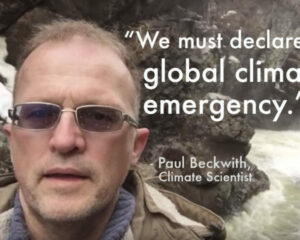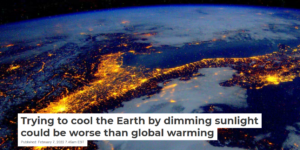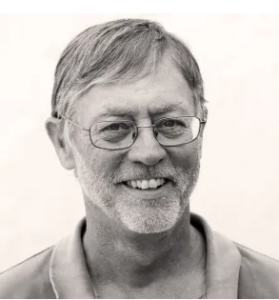Three U.N. Agencies warn of climate disaster. Canadian climate scientist Paul Beckwith joins Alex to cover the latest science. From the Land Institute in Kansas, author and plant breeder Stan Cox talks climate and food in destabilized times.
“We had our chance to make incremental changes, but that time is over….Only a root-and-branch transformation of our economies and societies can save us.”
– UNEP Director Inger Andersen [221027]
Listen to or download this Radio Ecoshock show in CD Quality (57 MB) or Lo-Fi (14 MB)
According to the Guardian’s Environment Reporter Damian Carrington, October 27, Potsdam Institute Director Johann Rockstrom said: “It’s a really bleak moment, not only because of the reports showing that emissions are still rising, so we’re not delivering on either the Paris or Glasgow climate agreements, but we also have so much scientific evidence that we are very, very close to irreversible changes – we’re coming closer to tipping points.”
********************************************************
At Radio Ecoshock, every week we broadcast science-based truth about the greatest threat ever faced by humanity. I’m Alex. Thank you for seeking out the hard truth, wherever it leads – and still caring about our world. Please help this show keep going with your donation.
***************************************
Nobody can wrap up the flood of worrying climate news like Damian Carrington, Environment Reporter for the Guardian Newspaper. Please support The Guardian – one of the few world-class climate reporting papers left.
From Damian Carrington:
“On Thursday, Shell and TotalEnergies both doubled their quarterly profits to about $10bn. Oil and gas giants have enjoyed soaring profits as post-Covid demand jumps and after Russia’s invasion of Ukraine. The sector is expected to amass $4tn in 2022, strengthening calls for heavy windfall taxes to address the cost of living crisis and fund the clean energy transition.
All three of the key UN agencies have produced damning reports in the last two days. The UN environment agency’s report found there was “no credible pathway to 1.5C in place” and that “woefully inadequate” progress on cutting carbon emissions means the only way to limit the worst impacts of the climate crisis is a “rapid transformation of societies”.
Current pledges for action by 2030, even if delivered in full, would mean a rise in global heating of about 2.5C, a level that would condemn the world to catastrophic climate breakdown, according to the UN’s climate agency. Only a handful of countries have ramped up their plans in the last year, despite having promised to do so at the Cop26 UN climate summit in Glasgow last November.”
The UN’s meteorological agency reported that all the main heating gases hit record highs in 2021, with an alarming surge in emissions of methane, a potent greenhouse gas.
Separately, the IEA’s world energy report offered a glimmer of progress, that CO2 from fossil fuels could peak by 2025 as high energy prices push nations towards clean energy, though it warned that it would not be enough to avoid severe climate impacts.
Rockström, director of the Potsdam Institute for Climate Impact Research in Germany, said: “It’s a really bleak moment, not only because of the reports showing that emissions are still rising, so we’re not delivering on either the Paris or Glasgow climate agreements, but we also have so much scientific evidence that we are very, very close to irreversible changes – we’re coming closer to tipping points.”
Research by Rockström and colleagues, published in September, found five dangerous climate tipping points may already have been passed due to the global heating caused by humanity to date, including the collapse of Greenland’s ice cap, with another five possible with 1.5C of heating.
“Furthermore, the world is unfortunately in a geopolitically unstable state,” said Rockström. “So when we need collective action at the global level, probably more than ever since the second world war, to keep the planet stable, we have an all-time low in terms of our ability to collectively act together.”
That was a lengthy quote from The Guardian, with Damian Carrington – but it all needs to be heard far and wide.
==============================
BREAKING SCIENCE WITH PAUL BECKWITH
The world is heading toward climate catastrophe. Who says so? The United Nations. On October 26, the World Meteorological Organization or WMO held a press conference in New York to confirm what Radio Ecoshock guests have been saying for more than a decade. Despite all the climate conferences, green talk and breathless announcements of new technology – all three of the worst greenhouse gases increased even more this year. We are headed toward catastrophic warming of 3 degrees C within this century.
So much mind-numbing and absolutely critical science arrived in the last three months. Our view of the world has been changed. We know more now, and our situation looks more dangerous than we knew. Even pessimists are a little shocked.
Although we interviewed some lead authors, like Luke Kemp with “Climate Endgame”, it is hard to keep up. That makes this a good opportunity to talk with the Canadian climate scientist Paul Beckwith. He tracks it all and has been churning out a steady stream of explainer videos for key science. This isn’t just science, you know. Really these are headlines from the future, including the near future and even today. Climate science has become the foundation for the news industry, with lots of breaking disaster news guaranteed.

All the heatwaves, fires and massive floods this past summer showed us all. For over a decade Canadian climate system scientist Paul Beckwith warned us about this, with over a thousand YouTube videos explaining the science behind it. Now Paul’s research field has moved from the fringe to center stage. He told you so, including in his many appearances on Radio Ecoshock. We are going to thrash through breaking climate science, and Paul’s plan to take it to the upcoming climate conference in Egypt this month.
Some of Paul’s work and my own intertwine. He does the video, I do the radio/audio and this little bit of print coverage. For example in mid-September I covered new work on methane clathrates, the frozen methane bombs sitting in the sea bed. Our guest was lead author Syee Weldeab. The paper is: “Evidence for massive methane hydrate destabilization during the penultimate interglacial warming”.
Paul’s YouTube video on this science is titled: “Massive Methane Hydrate Destabilization in the Past with Profound Implications for Today’s Climate”. We discuss what this could mean for future warming in this week’s interview.
On October 26th, the United Nations Environment Program released their report “Emissions Gap Report 2022: The Closing Window – Climate crisis calls for rapid transformation of societies”. They say greenhouse gas emissions are only increasing – and Earth is on track to become at least 2.8 degrees C hotter by the end of this century. NBC news gave that less than two minutes, and then spent ten times that on the latest mass murder, elections in Georgia, and general fluff.
In my view, the biggest blockbuster new paper is: “Climate Endgame: Exploring catastrophic climate change scenarios”. I spoke with the lead author Luke Kemp on our Ecoshock show released October 26. I urge listeners to grab that. Paul Beckwith did one of his longest videos yet on this paper. And he told us he intends to present on this Climate Endgame science at the COP27 climate conference in Sharm El_Sheikh Egypt in about a week. You can support Paul’s GoFundMe fundraiser to help pay his costs to get to COP27 here. We hope to have Paul as a correspondent from the climate conference as well.
Even more recently, Paul posted his video “Underwater Melting of Greenland Glaciers Amplified by BOTH Ocean Variability and Surface Meltwater”. That covered new science from Slater and Straneo titled “Submarine melting of glaciers in Greenland amplified by atmospheric warming”.
Paul has a presence on Facebook as well. He recently reposted this from the University at Albany (New York): “Study: Arctic Sea Ice Loss Leads to More Frequent Strong El Niño Events”. That sounds possible, but in my opening show in September I interviewed long-time scientist Dennis Hartmann who found climate-driven changes in Antarctica could bring more years like the last three, dominated by La Nina. Since “ENSO” includes the Southern Oscillation, it makes sense Antarctica is probably a larger driver of this see-saw of weather-makers in the Southern Hemisphere Pacific Ocean. I suppose these need not conflict: La Nina years may become more common, but when El Nino develops, watch out! Several scientist have suggested the next El Nino could take us into completely new levels of warming, storms and general disturbance of weather. It could even shift us to a new phase of warming. If we want to scare the heck out of each other, my pick is the next strong El Nino year.
Paul and I keep rolling through eye-popping new science. Speaking of Antarctica, humans finally managed to measure glacier movement where no human can go, underneath the Thwaites Glacier in Antarctica. Find this in the Open Access paper “Rapid retreat of Thwaites Glacier in the pre-satellite era” was published in Nature Geoscience on September 5, 2022.
How about this news: “Ocean Heat Has Doubled Since 1960s, Increasing Likelihood and Strength of Extreme Weather Events: Report”. The study is “Past and future ocean warming” by Lijing Cheng et al, published October 18, 2022. With tens of thousands of scientists working on the climate threat, it is impossible for anyone to keep up to it all. But does ocean heat doubling sound possible to you?
What about this one: “Climate Change is Closing Daily Temperature Gap, Clouds Could be the Cause”. That also came from a team of Chinese climate scientists, published September 23rd. in Geophysical Research Letters. Apparently, the difference between the daily high and nightly low are decreasing. That may affect the plant world significantly. The paper is: “Causes for Asymmetric Warming of Sub-Diurnal Temperature Responding to Global Warming”. It is Open Access and not a hard read if you want to know what this is all about. Plants and crops already know this.
CLIMATE PANIC; IS GEOENGINEERING NEXT?
So world leaders from the U.N. on down are finally ready to admit we are failing to control emissions and disaster seems pretty likely. The next step is surely an attempt at geoengineering to cool the planet. Our guest Luke Kemp who just lead the paper “Climate Endgame” studied injecting aerosols into the atmosphere and concluded it is too risky. But Paul Beckwith has been calling for cooling the Arctic for years. I ask him about his current position.

The thing is: you and I can report back from reality, using climate science, all the way down to collapse of this civilization. I think we need two big changes to save ourselves: 1. the fall of the fossil-fuel gatekeepers that profit from our disasters and 2. a public willing to admit we need big changes in our lives. Do you see any of that being possible?
I’m seeing more climate scientists going the route of pubic education, as you did. Our guest Kevin Trenberth just put out a public-friendly book explaining the way energy and climate work. Greenland scientist Kevin Box offers his video books series “Faster Than Forecast”. Michael Mann is public facing with his books too. But they can’t do it all, the detailed science and public speaking. We need a new role, some kind of large-scale medium – oh I don’t know, maybe a 24 hour seven days a week climate channel, or maybe even teach it to kids in school. How can we reach the world in time?
Some of my listeners have given up hope. They are stocking up beans and guns in a basement, hoping to stay alive somehow while the heat, storms and social breakdown unfold. Others are going on travel holidays, figuring this might be their last chance. How do you cope with what you know?
========================
AUTHOR STAN COX – FROM CROPS TO SAVING OURSELVES
Scorching heat in the U.S. South underlines absolute dependence on air conditioning, and the grid that powers all those machines. Now AC is moving much further North, to Portland and Seattle, never mind the oven that was Spain, Portugal, and Paris in 2022. Stan Cox wrote about all this in his 2010 book “Losing Our Cool: Uncomfortable Truths About Our Air-Conditioned World“. We talked about it on Radio Ecoshock. Twelve years after Stan Cox rang the bell on air-conditioning, machine cooling is spreading farther around a warming world. After the big heat dome of 2021, even folks in the cool NorthWest are installing A/C – and in Europe too! Of course that will make city sidewalks hotter and the whole world hotter as they burn fossil fuels to cool homes and businesses.
Listen to or download this 28 minute chat with Stan Cox in CD Quality or Lo-Fi
But there is another Stan Cox. Beyond his six books, by day Stan was for years lead breeder for The Land Institute’s Sorghum program. His work partnered with seven countries from India through Africa to America. We will find out why this food staple matters even more in a warming world. But now Stan has joined the Ecosphere Studies team at the Land Institute. He is tracking the global ecologic emergency. From Salina Kansas, we welcome Stan Cox back to Radio Ecoshock.

Author and plant breeder Stan Cox, The Land Institute
Taking a realistic view, some experts on climate change suggest humans will have to adapt. We may switch our diets to more heat resistant crops. Sorghum is often mentioned. Could Sorghum help feed a warming planet?
WE ARE NOT IN KANSAS ANYMORE
According to the Kansas State government, agriculture is the largest economic driver in the state, worth at least 76 billion dollars annually. That is bigger than the Gross Domestic Product of 130 countries. I heard the so-called “Dry Line” is advancing toward Kansas.
I ask Stan about the predicted climate future for this critical food-producing state. One of his answers surprised me: right in their experimental sorghum breeding fields, new insect pests have shown up in recent years. These little aphids and other bugs formerly only lived further south along the coast of the Gulf of Mexico. But now with warmer winter, the pests can survive further north. We humans like warmer winters, but so do bug who eat crops, and mosquitoes that can spread diseases. Winter warming is another underappreciated impact of global warming.
RECENT BOOKS FROM STAN COX
In 2020, Stan Cox published a book about “Ending the Climate Emergency While We Still Can”. Noma Chomsky wrote the forward. Do you think our current institutions can react quickly enough to save humanity from a more hostile climate?
In another book, one of the solutions Stan examined was rationing. The book is: “Any Way You Slice It – The Past, Present, and Future of Rationing.” That may come yet for energy-challenged countries in Europe this winter. But advertising still pushes everyone to consume as much as possible. As nature passes limits, the dream of endless production and consumption has to crash. Could rationing actually be socially redeeming?
His 2021 book is: “The Path to a Livable Future: A New Politics to Fight Climate Change, Racism, and the Next Pandemic”.
==========================================================
MORE BAD NEWS ABOUT MELTWATER ESCAPING AT THE POLES
Sea Level Rise Underestimated, and Currents Could Change
Last week I referenced a study led by Dr. James Kirkham, University of Cambridge. He described what would have been giant river channels underneath the ice sheet then covering most of the UK and the North Sea into Scandinavia until about 15,000 years ago. Those channels tell us more about how Greenland waters could escape – far more than we have been measuring falling into the sea as glaciers calve. That study is here.
New science just released reveals a similar water drainage system already exists deep under the Antarctic Ice Sheet. With research in the last few years, scientists discovered many lakes (not frozen!) down below the deep glacier at the South Pole. They assumed each lake was in an isolated basin.
Now Dr. Neil Ross (University of Newcastle) and colleagues found a sub-ice river 460 kilometers (285 miles) long. It reaches far inland and pours meltwater into the sea below the glaciers. Humans can’t see any of this, and that meltwater is not included in models projecting sea level rise – another source of underestimates. This may be just the start of mapping under-ice lakes and rivers in Antarctica. “The paper is: “Antarctic basal environment shaped by high-pressure flow through a subglacial river system.” Here is a helpful science press article about this new Antarctic river.
There is even more related science breaking on this. The new paper just out is: “Submarine melting of glaciers in Greenland amplified by atmospheric warming.” That is Open Access so go take a look. Of course Paul Beckwith already made a teaching video about this one too!
=========================================================
NEXT WEEK
We will look into the frightening wave of plastics into our world and right into our bodies. Wired Science Journalist Matt Simon joins us. And right now I have to call long-time Australian science journalist Julian Cribb – all for our show next week on Radio Ecoshock. I hope you will join us.
Image Credit for this week’s show: Milos Bicanski / Climate Visuals Countdown
Don’t forget to support Radio Ecoshock if you can. Thanks for listening – and reading this blog.
Alex Smith
Radio Ecoshock